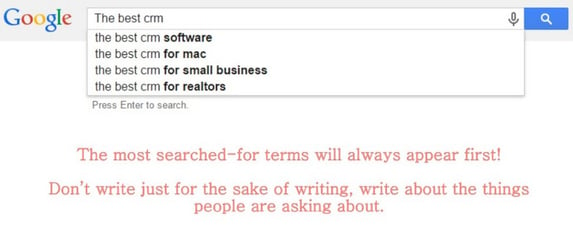
So you know you’re writing great content, but the question remains – who’s actually reading it?
Without optimizing your content for search engines, your efforts are likely to go undiscovered by the vast majority of your audience.
At a recent HubSpot Tel Aviv User Group event, the local inbound marketing community came together to share ideas and discuss industry best practices. Throughout his presentation, How To Use SEO to Get Your Content Discovered, Avishai Sam Bitton, Founder of Startup Bloggers, discussed his personal best SEO practices for content marketing.
Bitton describes his role as a mix of promoting his own personal brand through SEO and helping other companies & bloggers to promote their content using these same techniques.
Below are a few of the best practices he shared during his presentation, and how they can help get your content discovered.
Does SEO Still Work? Do You Really Need It?
As analogized by Bitton, good content is best compared to an absolutely stunning house. However, without SEO, that beautiful property might as well be located in the middle of the desert, where no one will ever find it.

There’s no question about whether you’d like to live in this gorgeous house – but would you rather it be in the middle of the Sahara Desert, or in the heart of Malibu?
“SEO isn’t difficult to learn,” says Bitton, “but it is difficult to follow.” To keep up with the ins and outs of the SEO world, Bitton makes sure to read the following blogs:
● QuickSprout
● Whiteboard Friday videos (from MOZ)
Of course, the biggest non-secret to mastering SEO is producing great quality content. And what’s Bitton’s recipe for good content? Seek out what YOU consider the best posts in a Google search.
Then figure out what’s missing, how it can be improved and turned into a better, more informative & engaging post. Now that’s the kind of content you should be writing!
SEO was, is, and will always be important to all of us in content marketing.
● If your content isn’t search-friendly, it won’t appear among the top-search results
● Appearing near the top of organic search results builds your credibility
● The best traffic is traffic from organic search queries
The real challenge comes from understanding the real-world components of optimizing your own content. These components include target audience research, understanding your buyer persona, who or what influences your prospects, and what challenges or unsolved problems your prospects may have that fit your area of expertise.
Loading Your Content Marketing SEO Toolbox
Companies such as Yelp, Engadget, TripAdvisor, and Wikipedia have built their platforms through search traffic. In addition to relying on SEO knowledge and best practices, chances are they couldn’t have done it without a few of the tools Bitton recommends.
What are the top 5 SEO tools worth investing in?
1. Open Site Explorer (from MOZ):
Open Site Explorer lets you see from where your competitors receive backlinks. With this, you’ll not only know one of the primary sources of your competitors’ SEO success, but you’ll be able to replicate it yourself and potentially outmaneuver them going forward.
Formulate and pitch a content package that can offer more value to those backlinking industry bloggers & thought leaders than can your competitors.
2. BuzzSumo:
To put it simply, BuzzSumo gives you X-ray vision; looking beyond the surface of the internet and seeing the underlying structure and mechanisms that give it its form. Except that instead of bones and muscles, you’re looking at influencers and content.
BuzzSumo tells you who the biggest “sharers” of given content topics are and what particular content engenders the most shares. Using this, you’ll know who to target your content to and how. (Bonus tool: Use Topsy to identify popular influencers and hashtags on Twitter).
3. SerpBook now: keyword.com
Serpbook provides rank-tracking services, which allow you to see your current ranking at any given time. Bitton says that it is very easy to burn time following your SEO results and tools like SerpBook save time by streamlining the tracking process.
Why write for the sake of writing, when you can guide your writing by what people want?
In other words, the best way to see what people are searching for can often be as simple as going to Google. Start typing in your keywords, and pay attention to what auto-completes. The most searched-for terms always appear first.

Using this technique, you can probe local or global demand at will. Google.com generates results from the entire web while each country (other than the US) has a unique domain extension (.co.uk, .fr, .ru etc.) that draws unique results.
5. TrenDemon:
Bitton is obsessive about bounce rate. He was keen to share a screenshot depicting the bounce rate of one of his sites – a mind boggling 2.2%.

To hear him tell it, there is a very simple secret sauce to this. The more people read your content, the lower the bounce rate will be. Using TrenDemon, you can recommend more content to your readers in real-time, either via a widget or an exit-intent popup.
“While there might not be a 100% correlation between high bounce rate and ranking, it is known that Google’s business model is based on providing the searcher with the content most relevant to his or her query. If the bounce rate from organic searches is high and the average time spent is 00:00:03, for example, it suggests that the content probably doesn’t directly address his/her intended inquiry.”
The imonomy blog just started using TrenDemon last week and the results are staggering:
● Bounce rate decreased by 10%
● Pages per user session improved by 25%
● Avg. time spent increased by 118%
Speaking of Google, has the search engine begun to usher in the apocalypse? Unless your site is already mobile-friendly, you better make yourself aware of the treacherous Mobilegeddon…
From Google:
Starting April 21 [2015], we will be expanding mobile-friendliness as a ranking signal. This change will affect mobile searches in all languages worldwide and will have a significant impact in our search results. Consequently, users will find it easier to get relevant, high quality search results that are optimized for their devices.
In other words, test your site to be sure it’s mobile-friendly. With the day of reckoning having come and gone, your rankings may have already taken a hit.
Webpages are mobile-unfriendly when text is rendered too small to read, mobile viewpoints are not set, and/or links are placed too close together for a mobile user’s fingers to be able to easily differentiate what they’re clicking on. Find out where you stand by taking Google’s Mobile-Friendly Test.
A SEO Hack You Can Use Right Now
Feel like you’ve been given too much SEO homework at once? No worries, here’s one tip from Bitton that you can start using right away. Look at the images you’ve used in your blog posts. Placement is key. Insert the image so that some of it will appear above your screen’s fold and some of it below the fold. This way, people may experience that “fear of missing out” (FOMO) and be more inclined to scroll down.
For more great tips on getting your content seen, be sure to check out our blog post about PPC vs SEO

by The Penguin Team on September 06, 2015
As a leading B2B digital marketing agency, We help B2B Technology Companies, enterprise software, and hardware companies increase brand awareness, reach more qualified leads and close more customers. Penguin Strategies is a Diamond Partner of HubSpot.





